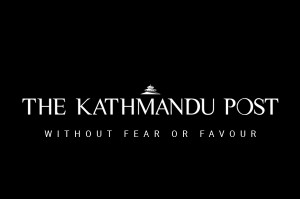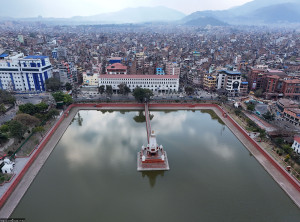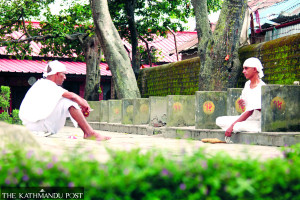Valley
Valley mayors for easing curbs; chief district officers wait for Home Ministry orders
Authorities’ confused response to the virus continues, as prohibitory orders, which have been in place for the last three weeks, end tonight. The sharp rise in the number of cases over the period shows the measure has proved to be largely ineffective.
Tika R Pradhan & Anup Ojha
The government’s confused response to the Covid-19 pandemic continued on Tuesday as well, as chief district officers of Kathmandu Valley were undecided on whether to lift or extend the ongoing prohibitory orders. Chief district officers of over 30 districts across the country also have imposed prohibitory orders as measures to contain the spread of the virus.
Chief district offices of the Valley–Kathmandu, Lalitpur and Bhaktapur–on Tuesday afternoon held a meeting with chiefs of security agencies and mayors from the districts to discuss whether to lift or continue the restrictions.
“We will hold discussion once again on Wednesday morning,” said Janak Raj Dahal, chief district officer of Kathmandu.
The prohibitory orders in the Valley were first imposed starting August 19 midnight for a week. But citing the continuous rise in the coronavirus cases, the restrictions were extended. The current prohibitory orders are applicable until Wednesday midnight.
On Tuesday, 396 new cases were reported from the three districts–300 in Kathmandu, 38 in Lalitpur and 58 in Bhaktapur.
While the cases have been rising, there are growing concerns over the hit the economy has taken. Meanwhile, concerns are also being raised about more people losing their jobs and struggling to make their ends meet.
Considering the difficulties the poor are facing and the impact on the economy, Kathmandu Valley Mayors’ Forum has suggested that restrictions be eased.
Officials said a decision on whether to extend the restrictions could not be taken on Tuesday due to differences in opinions.
Lalitpur Metropolitan City Mayor Chiri Babu Maharjan told the Post that mayors were of the view that restrictions should be eased in view of the difficulty it is causing in the everyday life of the people and the impact it is having on the economy.
“Life has become very difficult for people in the Valley. If businesses are not not allowed to operate, we will not be able to face pressure from the public and businesses,” said Maharjan, who is also an acting chairperson of the Kathmandu Valley Mayors’ Forum.
The mayors of the 17 municipalities, however, were for strict control on the entry of people into the Valley through major entry points and deployment of the army, if need be, for the purpose.
“The Nepal Police alone can’t handle the pressure of monitoring entry of vehicles into the Valley,” Maharjan told the Post.
The forum, according to Maharjan, is ready to intensify contact tracing and increase the number of polymerase chain reaction tests at the local levels.
Despite the prohibitory orders in place for the last three weeks, infections are growing at an alarming rate. As of Tuesday, 8,976 have been infected with the virus in the Valley. Of them, 6,478 were infected since prohibitory orders came into effect on August 19 midnight.
Pressure is mounting on the authorities also from the private sector businesspersons who say restrictions are not the solution to the pandemic and that if businesses are not allowed to reopen now, the country’s economy will take a massive beating.
According to the government data, Nepal’s economy saw a sharp slump in the third quarter of the last fiscal year–to 0.8 percent. Since the lockdown was enforced from March 24 to July 21, the fourth quarter, according to economists, is likely to be wiped out.
The country is into the first one and a half months of the current fiscal year, and restrictions have been in place in the Valley for the last three weeks and for about a month or so in various other districts, there are concerns that the first quarter will be discouraging
Economists are saying if the authorities fail to come up with a proper planning, Nepal will struggle to escape a negative growth this fiscal year.
Businesspersons told the Post on Monday that the authorities need to help reopen the economy, as the coronavirus threat will continue for long.
The authorities, however, seem to be caught in a rock and a hard place. Lifting the restrictions could result in the massive spread of the virus, which has already taken hold in society. Continuing the restrictions, on the other hand, can have massive repercussions on the economy and people’s livelihoods, as many might lose their jobs and small and medium enterprises could face closures.
With no integrated pandemic law in place, the federal government, however, is largely relying on its district administrators who are bureaucrats and not experts on disease control.
A chief district officer from the Valley told the Post that a decision whether to continue or lift the restrictions will be taken on Wednesday as per the Home Ministry’s instructions.
Madan Sundar Shrestha, secretary of the Kathmandu Valley Mayors’ Forum, said a meeting on Wednesday morning will decide on whether to continue the virus curbs, and if they are to be lifted, the modalities for the same.
Mayors and chief district officers from the Valley, however, are on the same page when it comes to tightening the entry points to Kathmandu. More than 2,000 people enter the Valley every day through various entry points..
“A decision on relaxing some services is likely though,” Shrestha told the Post.
The current prohibitory orders mean closure of all non-essential services. Public and vehicular movements have been barred. Shops for essential items are allowed to open till 11am.
“Discussions are ongoing to resume public vehicles, but the mayors’ forum has strongly objected to that idea,” said Shrestha. “Resuming public vehicles could spell a disaster. We are, however, not opposed to allowing private vehicles to ply with odd-even rules.”
According to Valley mayors, they are under intense pressure from the general public, as the last three weeks of restrictions have largely been ineffective, as they have failed to contain the virus spread while adding to people’s woes.
“We cannot continue with the restrictions in its existing form, as people are suffering,” said Shrestha. “We need to resume services gradually instead of completely lifting the restrictions. We need to come up with proper planning through extensive discussions.”




 21.1°C Kathmandu
21.1°C Kathmandu
.jpg)










